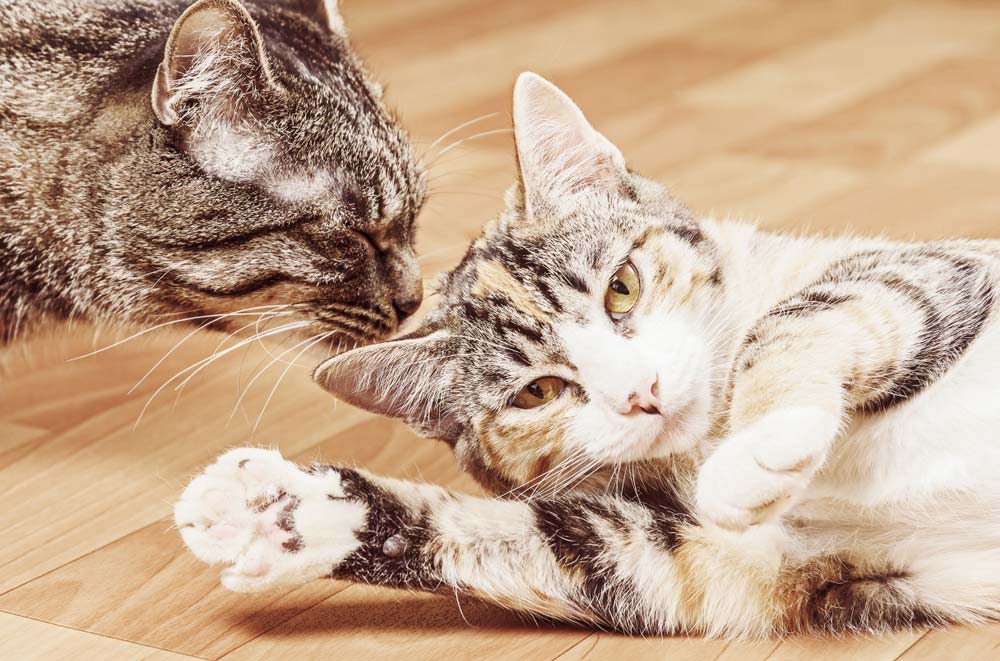By Linda Lombardi
Cats don’t need to live in groups, but cat lovers have a hard time stopping at just one, and the cats don’t get to choose their roommates. The result is that tension among felines in a household is a fairly common complaint. This can include overt fighting as well as behavior that’s more difficult for owners to notice. Conflict is not only bad for everyone’s quality of life, it can also result in health problems and in cats losing their homes.
A study published last year in the Journal of Feline Medicine and Surgery evaluated the effectiveness of a new pheromone product designed for multicat households called Feliway MultiCat (sold in Europe under the name Feliway Friends). While this was a pilot study, it was double-blind and tested against a placebo. The results suggest that this product can be effective in reducing inter-cat conflict when paired with education about cat behavior.
How the Study Was Conducted
Researchers recruited 45 participants with multiple cats (two to five per household) who had reported incidents of aggression for at least two weeks. All cats were at least six months of age and spent at least 16 hours per day indoors with unrestricted access to one another. Households with intact males and cats with a history of extreme aggression toward cats or humans were excluded. Also excluded were cats with medical conditions that would interfere with behavior evaluation or who had recently received psychotropic medications.
Participants were trained to recognize 12 behaviors to be monitored using the Oakland Feline Interaction Scale and recorded their frequency and intensity for seven weeks. They also were given instructions from a board-certified veterinary behaviorist on how to handle aggressive interactions, including using classical conditioning and redirection with positive reinforcement, and were strongly discouraged from startling the cats or using any form of punishment.
Participants were given a diffuser containing either placebo or the multicat product, which is a synthetic analog of the appeasement pheromone produced by mother cats during the nursing period. These were to be plugged in at an agreed-upon location in the home for 28 days, beginning one week after the orientation session. During use of the diffuser and for two weeks afterward, owners completed a daily diary consisting of answers to two questions about aggression between the cats, and a weekly questionnaire based on the Oakland Feline Interaction Scale. Of the 45 households, 17 in the treatment group and 25 in the placebo group completed the study.
What Happened
The number of aggressive incidents started to decline in both groups in the week before the diffusers started to be used, probably due to the behavior counseling received at orientation. However, the pheromone was found to have a significant effect. During the treatment period, aggression continued to decline in both groups, but the decrease was greater in the group that received the pheromone and the difference reached statistical significance on day 21. During the two weeks after the treatment period, the difference persisted, and conflict in the placebo group started to increase again.
At the end of the study, owners were asked if their cats seemed to be getting along better. In the pheromone group, 84.2 percent saw improvement, compared to 64 percent in the placebo group.
The authors note that one weakness of this study is that it relies entirely on owner report and that follow-up research should attempt to validate the reliability of behavior assessments. They add, however, that owner perception should not be downplayed, given that owner perception of conflict is what raises the risk of relinquishment. Longer term follow-up should also be a focus of future research.
The researchers conclude that this pheromone product showed a beneficial effect in reducing conflict in multicat households, in combination with education about cat behavior. The fact that the level of conflict began to decline after the orientation session and before pheromone treatment began shows the importance of that education, so overall results suggest that use of pheromones alone will not have the same effects.
This article was reviewed/edited by board-certified veterinary behaviorist Dr. Kenneth Martin and/or veterinary technician specialist in behavior Debbie Martin, LVT.





